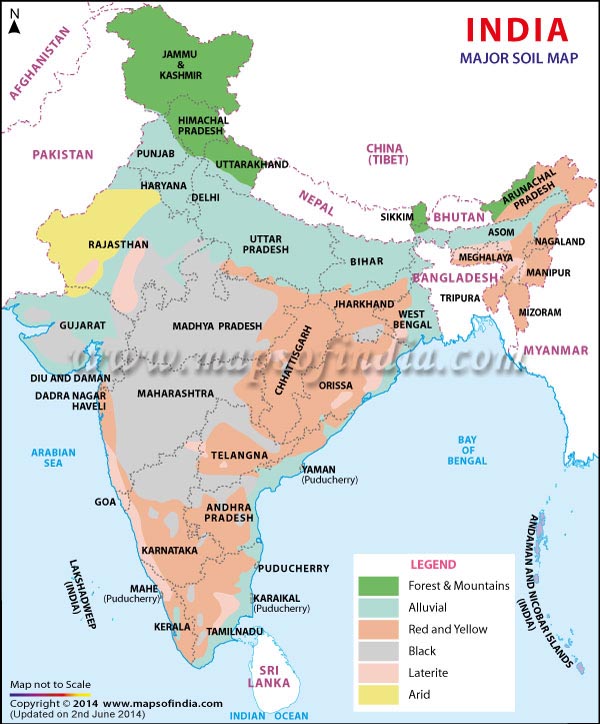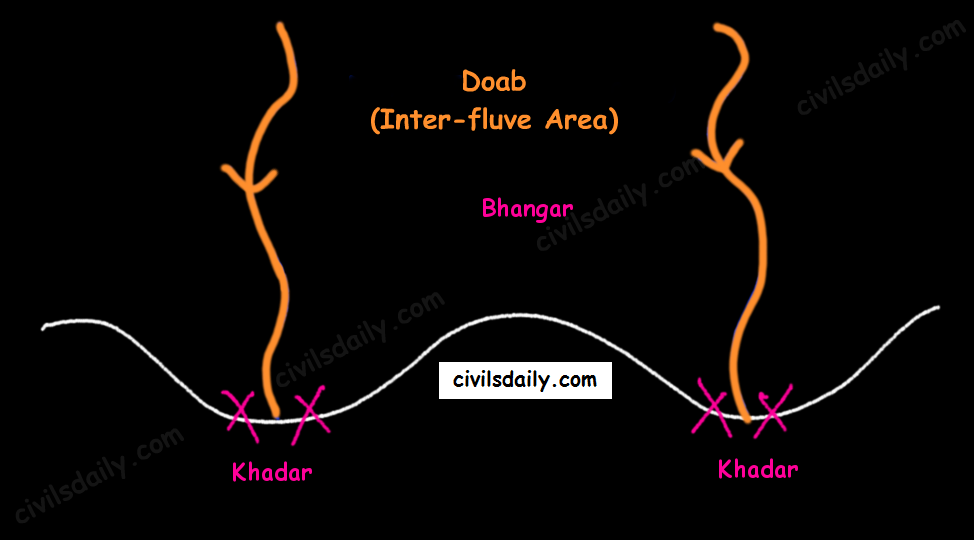We learnt about the various ways to classify soils. In this article, we will look at the various types of Indian soils in detail (According to ICAR’s classification). Let’s begin!
 Source
Source
1. Alluvial Soils
- Formation: They are mainly derived from the debris brought down from the Himalayas or the silt left out by the retreating sea. Thus they are azonal soils.
- Areas: Alluvial soils are widespread in the northern plains and the river valleys. Through a narrow corridor in Rajasthan, they extend into the plains of Gujarat. In the Peninsular region, they are found in deltas of the east coast and in the river valleys.
- Soil texture: The alluvial soils vary in nature from sandy loam to clay. These soils are more loamy and clayey in the lower and middle Ganga plain and the Brahmaputra valley. The sand content decreases from the west to east.
- Soil Colour: The colour of the alluvial soils varies from the light grey to ash grey depending on the depth of the deposition, the texture of the materials, and the time taken for attaining maturity.
- Other Characteristic Features:
- In the Upper and Middle Ganga plain, two different types of alluvial soils have developed, viz. Khadar and Bhangar.

-
- Khadar: the newer alluvium deposited by floods annually, enriches the soil by depositing fine silts, light colour, found near river beds, porous in nature.Bhangar: older alluvium, clayey, darker, has lime nodules called Kankars, found in doabs (inter-fluve areas).
- Alluvial soils of the northern plains —> transported soils —> therefore lack humus —> lack nitrogen [That is why we need to use nitrogenous fertilisers in the northern plains!]. Exception: the Ganga-Brahmaputra delta region is rich in humus.
- These soils lack in nitrogen, phosphorus and humus. However, they are generally rich in potash and lime.
- The soil profile has no stratification.
- Alluvial soils are intensively cultivated.
- In certain areas, these soils are covered with unproductive wind-borne soil called Loess.
- Limitations:
- Allow water to sink into lower strata, and
- Lack nitrogen (But these soils are capable of fixing nitrogen very rapidly through leguminous crops (peas, beans, cloves etc.)
- Suitable Crops: Wheat, rice, maize, sugarcane, pulses, oilseeds, fruits and vegetables, leguminous crops.
2. Black Soil
- These soils are locally known as the ‘Regur Soil’ or the ‘Black Cotton Soil’. Internationally, these are known as ‘tropical chernozems’. These soils are famous for the cultivation of cotton.
- Formation: These have mainly formed from the Deccan Trap rocks —> Zonal Soils
- Areas: These are found in the Deccan trap region. Black soil covers most of the Deccan Plateau which includes parts of:
- Maharashtra,
- Madhya Pradesh,
- Gujarat,
- Andhra Pradesh and some parts of
- Tamil Nadu.
- Soil Texture: Black cotton soil (regur soil) is highly argillaceous i.e. clayey. It is deep and impermeable and thus has high water retention capacity.
- Soil Colour: These soils are black in colour due to the presence of iron, aluminium compounds and humus.
- Other Characteristic Features:
- These soils are rich in minerals and known for their fertility.
- The soil depth varies from place to place. It is very thick in lowlands but very thin on highlands. Also, in the upper reaches of the Godavari and the Krishna, and the northwestern part of the Deccan Plateau, the black soil is very deep.
- These soils swell and become sticky when wet and develop deep wide cracks when dry. This helps in self-aeration, which leads to absorption of nitrogen from atmosphere. Thus, there occurs a kind of ‘self ploughing’. This aeration and oxidisation to deep levels contributes to maintenance of fertility of these soils. This continued fertility is favourable in the area of low rainfall for cotton cultivation even without irrigation.
- Due to slow absorption and loss of moisture, the black soil retains the moisture for a very long time, which helps the crops, especially, the rain fed ones, to sustain even during the dry season.
- Chemically, the black soils are rich in lime, iron, magnesia and alumina. They also contain potash. But they lack in phosphorous, nitrogen and organic matter.
- Suitable Crops: These soils are highly productive and well suited to the cultivation of cotton, pulses, millets, linseed, tobacco, sugarcane, vegetables and citrus fruits.
Note: In the southern and eastern parts of the country where rainfall is heavy, black soils often occur in close proximity to red soils. Black soils occupy valleys and low-level areas whereas the red soils occur on higher slopes and hill tops. Mixed black and red soils occur in Coimbatore, Madurai, Tirunelveli (Tamil Nadu) and Bundelkhand region.
3. Red and Yellow Soils
- Locally called ‘Chalka’ in Andhra Pradesh.
- Formation: These are derived from granites, gneisses and other metamorphic rocks —> Zonal Soils. These are formed under well-drained conditions.
- Areas: Along the piedmont zone of the Western Ghat, a long stretch of area is occupied by red loamy soil. Yellow and red soils are also found in parts of Orissa and Chattisgarh and in the southern parts of the middle Ganga plain. They encircle the black cotton soil zone.
- Soil Colour: The soil develops a reddish colour due to a wide diffusion of iron in crystalline and metamorphic rocks. It looks yellow when it occurs in a hydrated form. Often, their upper layer is red and the lower layer is yellow.
- Soil Texture: Varies from sand to clay and loam.
- Other Characteristic Features:
- The fine-grained red and yellow soils are normally fertile, whereas coarse-grained soils found in dry upland areas are poor in fertility.
- Have a porous and friable structure.
- They are generally poor in nitrogen, phosphorous and humus.
- These soils are airy and need irrigation for cultivation.
- Intense leaching is a menace in these soil areas.
- Suitable Crops: In places where irrigation facilities are available, the crops cultivated are wheat, cotton, pulses, tobacco, millets, oilseeds, potato, maize, groundnut and orchards.
4. Laterite Soil
- The word laterite has been derived from the Latin word ‘Later’ which means brick. These soils when wet are as soft as butter but become hard and cloddy on drying. Therefore, these are widely cut as bricks for use in house construction.
- Formation: The lateritic soils are particularly found on high flat erosion surfaces in areas of high(>200cm) and seasonal rainfall. The alternating wet and dry seasons lead to the leaching away of the siliceous matter of the rocks leaving behind the compounds of iron and aluminium. These are zonal soils.
- Areas: These soils have mainly developed in the higher areas of the Peninsular plateau. The laterite soils are commonly found in Karnataka, Kerala, Tamil Nadu, Madhya Pradesh and the hilly areas of Orissa and Assam.
- Soil Colour: Reddish brown in colour due to the presence of iron oxide.
- Other characteristic features:
- With rain, lime and silica are leached away, and soils rich in iron oxide and aluminium compound are left behind(thus the reddish brown colour). Also, humus content of the soil is removed fast by bacteria that thrives well in high temperature.
- These soils represent the end product of decomposition and are generally low in fertility.
- The pebbly crust is the important feature of laterites which is formed due to alteration of wet and dry periods.
- These soils are acidic in character due to leaching. Application of manures and fertilisers is required for making these soils fertile for cultivation.
- These soils are poor in organic matter, nitrogen, phosphate and calcium, while iron oxide and potash are in excess.
- Suitable crops: Red laterite soils in Tamil Nadu, Andhra Pradesh and Kerala are more suitable for tree crops like cashewnut. These soils are also suitable for tea plantations.
That’s it for this part!


Soils Part 4 chapter is missing here. Please if you can add this section, it would be really helpful.